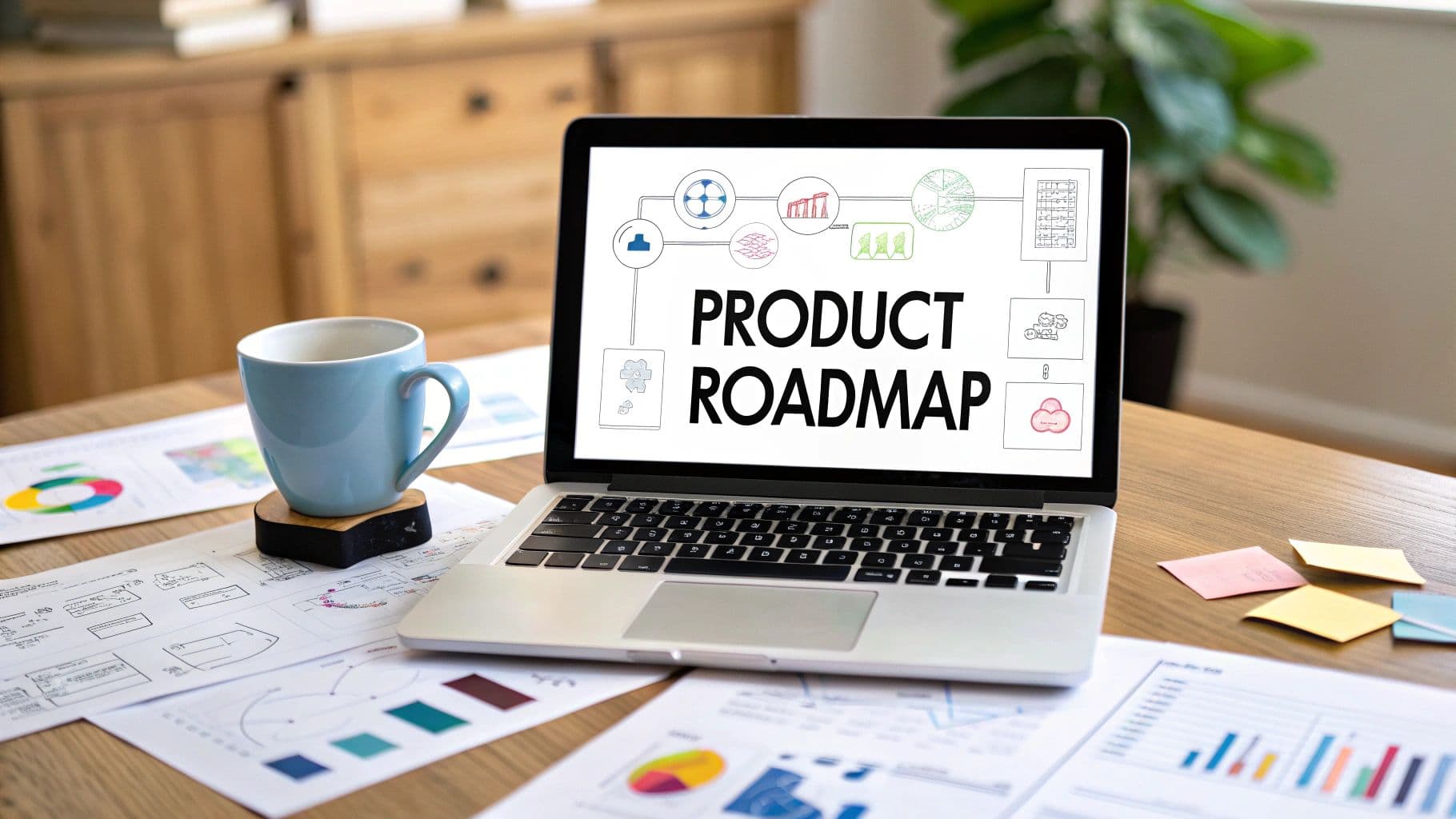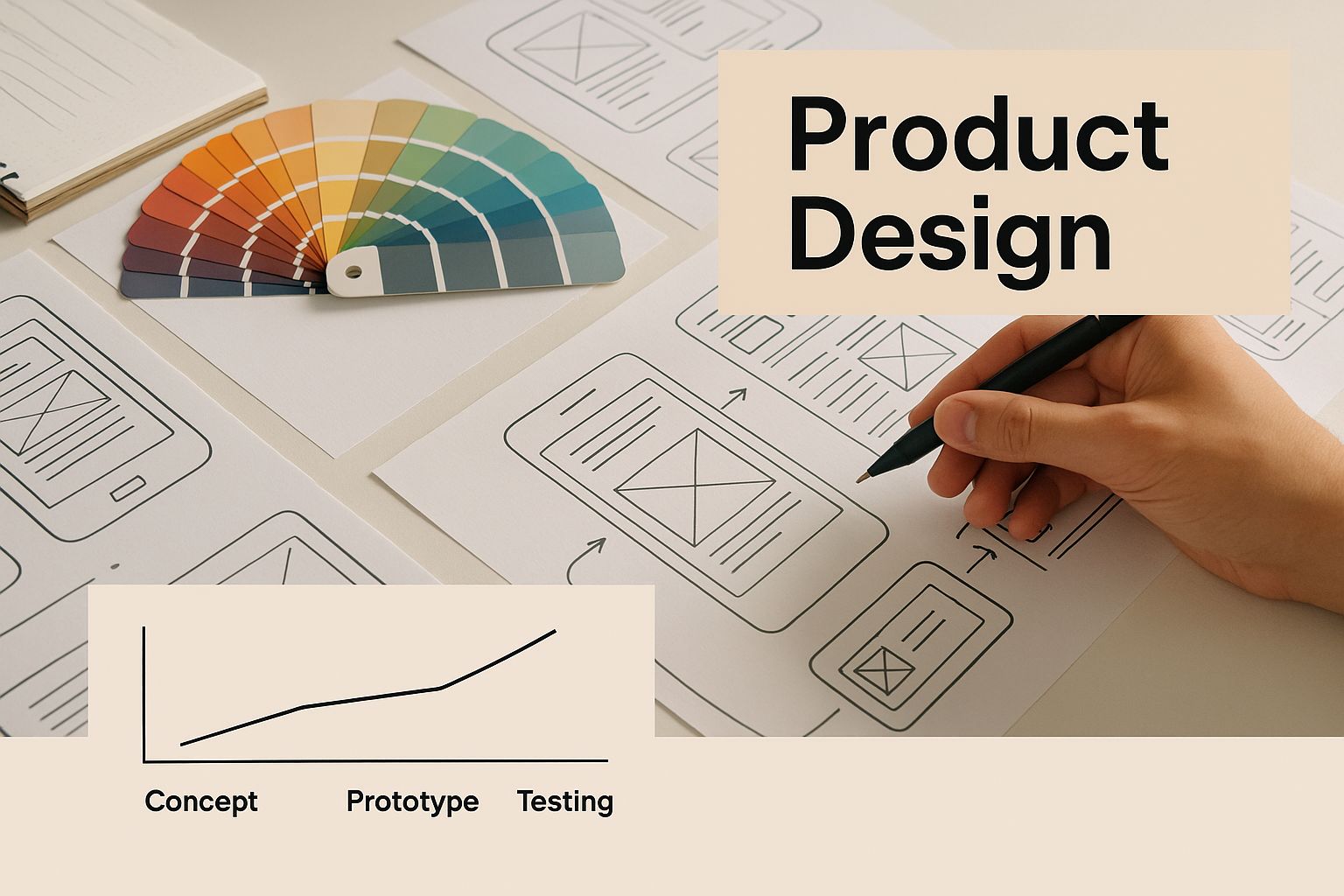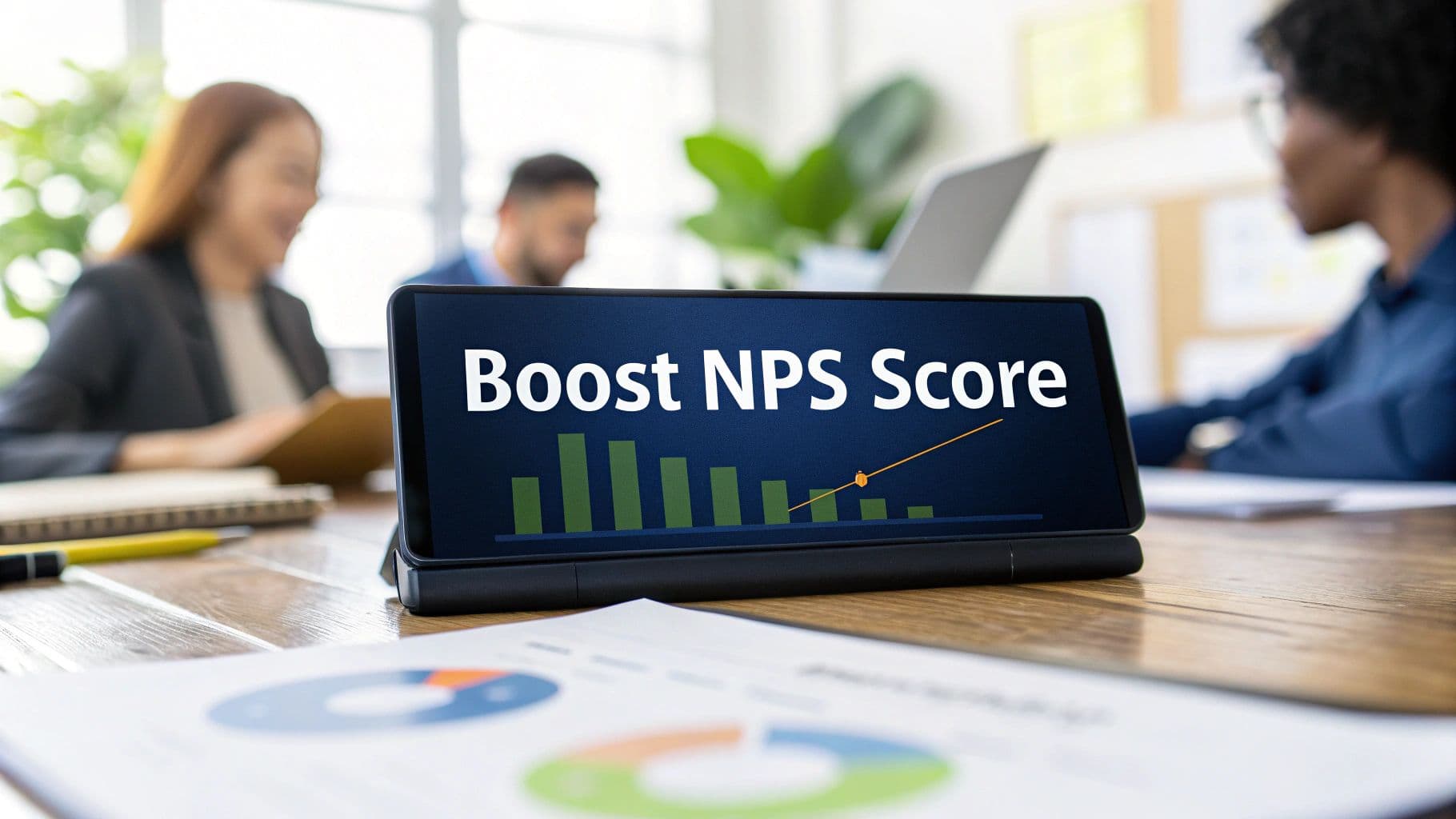Create an Effective Product Development Roadmap | Strategies & Tips
Learn how to develop a clear product development roadmap that aligns teams, prioritizes goals, and drives growth. Start building yours today!

Think of a product development roadmap as the story of your product's future. It’s not just a dry timeline of features; it’s the single source of truth that aligns your entire organization on the ‘why’ behind the work. This visual plan is what connects your company's high-level ambitions to the real problems you're solving for customers.
Why a Roadmap Is Your Most Critical Tool
Let's be direct—working without a product development roadmap is like setting sail without a map. You might be busy and feel like you're making progress, but you’re probably just drifting. The roadmap is the central nervous system of your product strategy. It’s what turns a lofty vision into an actionable plan everyone can actually get behind.

A well-crafted roadmap does so much more than just track tasks. It serves a few crucial functions that prevent the all-too-common chaos of misaligned teams and wasted effort.
- Creates Strategic Alignment: It gets everyone rowing in the same direction—engineering, marketing, sales, support, you name it. When the sales team knows what’s coming, they can manage customer expectations. When marketing understands the value you're about to deliver, they can craft campaigns that actually land.
- Facilitates Communication: It’s your number one communication tool. It clearly lays out the product's direction for executives, investors, and other stakeholders, showing them exactly how development work ties back to the bigger business goals.
- Guides Prioritization: Resources are always finite. Every decision to build one thing is a decision not to build something else. A roadmap gives you the strategic context you need to make those tough calls, keeping the team focused on work that delivers the biggest punch.
The Real Cost of Neglecting Your Roadmap
The consequences of flying blind are very real and very expensive. In fact, unclear company strategies are a major reason why nearly 23% of product development investments fail. The flip side? A whopping 66% of businesses that nail the alignment between their company strategy and product development report much better results. You can discover more about how strategy impacts product success on wearetenet.com.
Without a roadmap, teams inevitably fall into a reactive trap. They start chasing competitor features or scrambling to fix whatever the loudest customer is complaining about today. This "feature factory" approach creates a bloated, unfocused product that’s a mile wide and an inch deep.
Here's a quick look at the core elements that make a roadmap a truly strategic asset, not just a glorified to-do list.
Key Components of a Powerful Roadmap
| Component | Description | Why It Matters |
|---|---|---|
| Product Vision | A concise statement that describes the long-term goal of your product. | Provides the "North Star" that guides all decisions and inspires the team. |
| Business Goals | Specific, measurable objectives the product needs to achieve (e.g., increase MRR by 15%). | Connects development work directly to tangible business outcomes and value. |
| Themes & Initiatives | High-level problem areas or goals you plan to address (e.g., "Improve Onboarding"). | Groups features into logical, customer-centric buckets instead of a random list of tasks. |
| Timeline (General) | A broad timeframe—often quarterly or "Now, Next, Later"—for when initiatives will be tackled. | Sets expectations without locking the team into rigid, unrealistic deadlines. |
| Metrics & KPIs | Key Performance Indicators used to measure the success of each initiative. | Ensures you're not just shipping features but actually solving problems and moving the needle. |
| Status Indicators | Simple labels (e.g., In Progress, Planned, Under Consideration) to show progress. | Offers a quick, at-a-glance understanding of where things stand for all stakeholders. |
A great roadmap is a living document, but these components provide the essential structure that keeps everyone grounded in the strategy.
Imagine this scenario: the engineering team spends three months building a complex new feature requested by a single, large client. At the same time, the support team is buried under tickets about a critical performance issue slowing the app down for almost everyone. Without a roadmap to visualize priorities and weigh them against broad customer impact, the team chose a niche request over a widespread problem. The result? Frustrated users and potential churn.
Ultimately, a product development roadmap isn't just a document; it's a discipline. It forces strategic thinking, drives proactive communication, and gives you the clarity to navigate the messy reality of building great products.
Building Your Strategic Foundation
A great product roadmap isn't just a wish list of features or a wild guess at what to build next. It's firmly rooted in a solid strategy, connecting every single development effort back to a bigger purpose. Before you even think about what to build, you have to nail down the why—the reason that will guide your decisions, shape your priorities, and get your team excited.
It all starts with a compelling product vision. Think of this as your North Star. It’s a clear, ambitious statement about the future you want to create for your customers. For instance, a B2B SaaS company might have a vision to "eliminate manual data entry for finance teams." That's not a feature; it's a destination. It gives the entire journey meaning.
From Business Goals to Product Goals
Once your vision is set, the real work begins: turning high-level business objectives into concrete product goals. Your executive team isn't thinking about features; they're focused on growth, revenue, and market share. Your job as a product leader is to bridge that gap.
Let's say a business objective is to "increase market share by 15% in the enterprise segment." That’s far too broad for your product team to act on. You need to translate it into something they can actually build.
- Business Objective: Increase enterprise market share by 15%.
- Product Goal: Develop an advanced security and compliance feature set to unblock sales with Fortune 500 companies.
- Key Result: Achieve SOC 2 Type II compliance and close three new enterprise deals within two quarters.
This translation is everything. It ensures your engineering team isn't just building cool stuff in a vacuum; they're directly driving the company's success.
Gathering and Synthesizing Critical Inputs
Your strategy can't be cooked up in a conference room. It needs to be fueled by a constant flow of information from the outside world. The real skill is learning how to synthesize all these different inputs and spot the patterns that signal a genuine opportunity. This is how your roadmap becomes a reflection of real-world needs, not just internal assumptions.
I've found that a few key sources consistently provide the richest insights:
- Customer Support and Success Channels: Don't just look at support tickets and chat logs as problems to be solved. They're a goldmine of user pain points. Are customers constantly asking how to do a specific task? Have they invented clunky workarounds because a feature is missing? These aren't just complaints; they are bright, flashing signs pointing you toward your next high-value project.
- Sales and Go-to-Market Teams: Your sales team is on the front lines every day, hearing directly from prospects why they buy—or, more importantly, why they don't. A common objection like, "Your platform doesn't integrate with our existing CRM," is an incredibly powerful signal. If you're consistently losing deals for the same reason, you've just identified a strategic gap your roadmap absolutely must address.
- Competitor Analysis: Keeping tabs on your competitors isn't about blindly copying their features. It’s about understanding their strategy. Did a major rival just launch a key integration or move into a new market? That tells you where they see the industry heading and forces you to think critically about how your own strategy should respond.
Ultimately, laying this groundwork transforms your roadmap from a simple project plan into a powerful communication tool. It ensures every item on your list has a clear, defensible reason for being there, tying it directly back to solving a real customer problem and hitting a core business objective.
Prioritizing What to Build Next
Once you have a solid strategy, the real fun begins: figuring out what to build first. You’re likely swimming in a sea of feature requests, user feedback, bug reports, and a dozen "brilliant ideas" from last week's brainstorm. It’s easy to get overwhelmed. The key is to move from making gut calls to making confident, data-backed decisions. This is where a good prioritization framework becomes your best friend.
Without a system, it’s all too common for teams to just build what the loudest customer is screaming for, or what the highest-paid person in the room (the "HiPPO") suggests. Let's be honest, that's a recipe for a roadmap that goes nowhere fast. A solid framework cuts through the noise and forces you to stack up every idea against the same set of criteria.

As you can see, the whole process is a mix of creative thinking and sharp analysis. It ensures every single choice you make actually serves your bigger goals.
The RICE Scoring Model Explained
One of the most practical and popular frameworks out there is RICE. It’s an acronym for Reach, Impact, Confidence, and Effort. Think of it as a simple but powerful scoring system that helps you quantify the potential value of each initiative, so you can compare everything on a level playing field.
During planning, the goal is ruthless prioritization of features that truly support the product vision. I've seen many teams use the RICE framework to get this done right. If you want to dive deeper, there's a great guide to strategic roadmap planning on netguru.com that covers similar concepts.
Here’s how you can put RICE to work:
- Reach: How many people will this feature actually touch in a given timeframe? A tweak to your sign-up flow might reach 100% of new users, while a niche reporting tool might only hit 5%. Get specific here.
- Impact: How much will this move the needle on your most important goal (like conversion, adoption, or retention)? I find it helpful to use a simple scale: 3 for massive impact, 2 for high, 1 for medium, 0.5 for low, and 0.25 for minimal.
- Confidence: This is your reality check. How sure are you about your Reach and Impact numbers? A 100% confidence score is for something backed by hard data. An 80% score might be for a well-researched idea, while a 50% score is for those high-risk, high-reward "moonshots."
- Effort: How much time will this really cost your team—product, design, and engineering included? We usually measure this in "person-months." A small copy change could be 0.5 person-months, but a whole new feature set could easily be 6 person-months or more.
Other Battle-Tested Frameworks
RICE is fantastic, but it's not the only tool in the shed. Different situations call for different methods. The best product managers I know have a few frameworks in their back pocket and know when to use each one.
Here's a comparative analysis to help you select the best prioritization method for your product, team, and current strategic goals.
Choosing Your Prioritization Framework
| Framework | Best For | Key Benefit | Potential Drawback |
|---|---|---|---|
| RICE | Data-driven teams looking to objectively compare disparate ideas. | Forces quantitative thinking and removes emotion from decisions. | Requires good data for accurate Reach and Impact estimates. |
| MoSCoW | Defining scope for a specific release or sprint with fixed deadlines. | Creates crystal-clear alignment on what's in and what's out. | Can lead to stakeholders trying to classify everything as a "Must-Have." |
| Kano Model | Teams focused on user satisfaction and competitive differentiation. | Uncovers opportunities for "delight" features that customers don't expect. | More qualitative and requires direct customer research to be effective. |
Let's briefly touch on MoSCoW and Kano.
The MoSCoW Method is brilliant for getting everyone on the same page about scope. It forces you to bucket features into four categories:
- Must-Have: Absolutely non-negotiable. The product is broken or useless without these.
- Should-Have: Important and add a lot of value, but not critical for launch.
- Could-Have: "Nice-to-haves" that you'll tackle if there's time.
- Won't-Have: Things you all agree are out of scope for now.
Then there's the Kano Model, which is all about understanding customer delight. It helps you see features through your users' eyes by classifying them into three groups:
- Basic Features: The stuff people just expect. They won't thank you for having them, but they'll be furious if they're missing.
- Performance Features: The more of this you give them, the happier they are (e.g., more storage, faster load times).
- Excitement Features: The unexpected surprises that make users say "wow!" and tell their friends.
By using these frameworks, you're not just guessing anymore. You’re turning prioritization from a subjective art into a repeatable science, giving you a clear, defensible reason for every single decision you make.
Visualizing Your Roadmap for Real Impact
You’ve done the hard work of setting your strategy and wrestling with priorities. Now it's time to bring that plan to life. A roadmap that stays locked in a spreadsheet or a dense document is a roadmap that will ultimately be ignored. Your real goal is to create a compelling visual story—something that communicates your entire strategy at a glance.
This isn't just about making things look pretty. It's about crafting a narrative that's digestible and actionable for everyone involved. Think about it: the way you present your plan to the C-suite needs to be fundamentally different from how you'll discuss it with your engineering team. The visual format you choose is a critical part of the message.
Moving Beyond Feature-Based Timelines
One of the most common traps I see teams fall into is creating a feature-based roadmap with rigid delivery dates stretching months, or even years, into the future. This approach is incredibly brittle. It sets everyone up for failure because the moment a single deadline slips or a priority shifts, the entire document becomes obsolete and you start losing credibility.
A much more effective and resilient method is the theme-based roadmap. Instead of just listing features, you organize the work around the high-level customer problems you're setting out to solve.
- A feature-based item might be: "Implement single sign-on (SSO)."
- A theme-based initiative would be: "Streamline Enterprise User Authentication."
See the difference? The theme puts the focus squarely on the why—the customer outcome—not just the what. This gives your development team the creative freedom to find the best possible solution while keeping stakeholders aligned on the bigger strategic picture.
The Power of Now, Next, Later
To go along with a theme-based structure, many of the best product leaders I know have abandoned specific quarterly deadlines for a more fluid time horizon. The most popular format, for good reason, is Now, Next, Later.
This structure is brilliant because it manages expectations perfectly while keeping everyone pointed in the right direction. It provides just the right amount of clarity for each timeframe.
- Now: This is what the team is actively building. These items are well-defined, scoped out, and have a high degree of certainty. There should be no ambiguity about what's in this column.
- Next: These are the themes and initiatives teed up for the near future. The customer problem is well-understood, but the specific solutions are still being explored and designed.
- Later: This is your bucket for valuable ideas and future opportunities. These items align with the product vision but need a lot more research and validation before they're even considered for the 'Next' column.
This format simply grounds your roadmap in reality. It’s an honest acknowledgment that the further out you look, the less certain things become.
Tailoring Your Roadmap for Different Audiences
A single, one-size-fits-all roadmap is a myth. Different stakeholders have different needs, and a good roadmap anticipates this. Learning to create tailored views of your roadmap is a communication superpower.
Here’s a practical way to think about it:
| Audience | What They Need to See | Best Format to Use |
|---|---|---|
| Executive Team | A high-level view connecting initiatives to business goals and key metrics. They care about the why and the impact. | A goal-oriented or theme-based roadmap showing 'Now, Next, Later' horizons. |
| Development Team | A detailed look at the 'Now' column, with clear links to the epics and user stories they'll be working on. | An internal view that connects roadmap themes directly to a tool like Jira. |
| Sales & Marketing | Key customer-facing themes and the anticipated outcomes so they can build a solid go-to-market strategy. | A simplified, external-facing version that focuses on the customer problems you're solving, not internal deadlines. |
Choosing the Right Tool for the Job
Your roadmapping tool should support your visualization strategy, not dictate it. You absolutely do not need a complex, expensive system right out of the gate.
- When you're starting out: A simple tool like Trello or even a well-organized Google Sheet can be perfect for managing a 'Now, Next, Later' board.
- As your team grows: When things get more complex, dedicated roadmapping software like Aha! or ProductPlan can be a lifesaver. These tools are built specifically for creating and sharing different views of your roadmap and connecting your high-level strategy to the day-to-day execution in tools like Jira.
At the end of the day, the best roadmap format is the one that sparks the right conversations and keeps everyone aligned on the journey ahead.
Keeping Your Roadmap Agile and Alive

Here’s where many teams stumble: they finally finish the roadmap, breathe a sigh of relief, and treat it like a finished artifact. They print it out, pin it on a wall, and consider the job done. But that's a huge mistake.
A product roadmap isn’t a stone tablet. It's a living document that has to change as you learn more about your customers, your product, and the market you operate in. An outdated roadmap is actually worse than having no roadmap at all—it creates confusion and kills credibility with your stakeholders.
Find Your Review Rhythm
The only way to keep a roadmap relevant is to build a habit of reviewing it. You have to bake regular check-ins into your team’s culture. For most teams, a quarterly strategic review hits the sweet spot.
This isn’t just another meeting to talk about what you’ve shipped. It’s a dedicated time to zoom out and ask the hard questions:
- How are we tracking? Did the things in our "Now" column have the impact we expected? What did we learn?
- What's the data telling us? Are there new trends in our user analytics, support tickets, or sales calls?
- What's happening in the market? Did a competitor make a move? Is there a new technology we should be paying attention to?
- Are our priorities still right? Based on all this, are the items in our "Next" and "Later" columns still the most valuable things we could be doing?
Think of it as a tune-up for your product strategy. It ensures the roadmap reflects reality, not the assumptions you made three months ago.
Your roadmap's value is directly tied to its relevance. A plan that doesn't adapt to new data is a plan that is destined to fail. The goal is to be stubborn on the vision but flexible on the details.
This systematic review process turns the roadmap from a source of pressure into a source of confidence. It gives your team permission to learn and react, ensuring you’re always investing your precious development resources in the highest-impact work.
Build Strong Feedback Loops
Of course, a review is only as good as the information you bring to it. This is why you need to create channels for insights to flow from the front lines right into your planning process. Don't just listen—systematize how you collect and analyze feedback.
This is becoming an increasingly data-driven process. A Gartner report predicted that by 2025, 76% of product leaders will increase their investment in AI tools to power these kinds of strategic decisions. It’s a clear shift toward using technology to find the signal in the noise. You can learn more about the future of product management on userback.io.
Here are a few practical ways to build these loops:
- Tag everything. Work with your support and success teams to tag every single customer conversation. Tagging tickets by theme (e.g., "login-issues," "reporting-request") lets you quantify pain points and spot problems before they blow up.
- Talk to your customer-facing teams. Regularly schedule "Voice of the Customer" sessions with sales and customer success. Ask them direct questions like, "What feature request came up on three different calls last week?"
- Live in your product analytics. Set up dashboards to monitor key user behaviors, especially for new features. Are people actually using that new thing you just launched? Where are they getting stuck? This quantitative data is the perfect gut check for your qualitative feedback.
How to Handle Curveballs
No matter how well you plan, things will go sideways. A competitor will launch a game-changing feature. Your company will suddenly pivot its strategy. This is where an agile roadmap really shines.
When a disruption hits, the first instinct is to panic and throw the plan out. Don't. Your roadmap gives you the framework to handle this calmly and strategically. It lets you have a structured conversation about trade-offs.
For instance, if a competitor’s surprise launch forces your hand, you can ask a simple question: "To build a response to this, which of our current 'Next' initiatives are we willing to delay or kill?" This approach turns a chaotic, reactive moment into a deliberate, strategic decision, keeping you in the driver's seat.
Answering the Tough Roadmap Questions
Once you’ve built your roadmap, the real work begins. The plan is one thing, but navigating the daily reality of requests, shifting priorities, and stakeholder questions is another entirely. These are the conversations that happen in the trenches, and having solid answers ready can make all the difference.
Let's break down some of the most common questions and curveballs you'll face. Getting these right keeps your team on track and builds trust with everyone from the C-suite to the sales floor.
How Much Detail Is Too Much Detail?
This is a classic. The truth is, the level of detail on your roadmap should change depending on how far out you're looking. Think of it like a camera lens—you want sharp focus on what’s right in front of you and a wider, less defined view of the horizon.
- Now (This Quarter): Get specific. This part of the roadmap needs to be packed with clear epics and well-understood user stories. Your engineering team is working on this right now, so there’s no room for ambiguity.
- Next (2-3 Quarters Out): Zoom out a bit. Instead of individual features, focus on bigger problems or strategic themes. For example, "Improve the mobile checkout experience" or "Streamline the new user onboarding flow." You've validated the why, but the specific how is still flexible.
- Later (Beyond That): Keep it broad. This is where you map out big, high-level opportunities or strategic bets that require more research. Listing specific features here is a trap. It creates false expectations and locks you into promises you can't possibly keep.
Your roadmap is a statement of intent, not a project plan with Gantt charts. If your “Later” column reads like a backlog, you've gone too far. The goal is direction and flexibility, not rigid, long-term commitments.
Dealing with "Urgent" Requests and Pet Features
It happens every time. A senior exec returns from a conference with a "game-changing idea," or a key customer threatens to walk unless you build their one specific feature. The knee-jerk reaction is to either say yes and throw your plan into chaos or say no and look uncooperative.
Don't do either. Use your roadmap as your shield. The conversation isn't about yes or no; it's about trade-offs.
Here's a response I’ve used that works wonders: "That's an interesting idea. To tackle that, we'd need to pause our work on [Theme from the 'Next' column], which we've prioritized because it addresses [Business Goal]. Let's look at the data for both and figure out which one gets us closer to our Q3 targets."
This approach is powerful for two reasons:
- It immediately shows that your roadmap is a product of deliberate, strategic thinking, not just a random to-do list.
- It reframes the conversation from a top-down demand to a collaborative decision based on value and impact.
How Often Should We Update the Roadmap? And Who Needs to Know?
Your roadmap is a living document, not a stone tablet. A quarterly strategic review is a healthy rhythm for making any major shifts to your "Next" and "Later" columns. But the status of what's in "Now" will obviously change much more often as work progresses.
The most important part isn't how often you update it, but how you communicate those updates.
No one likes to be blindsided. When a priority changes, don't just quietly drag a card in Jira. Announce the change and—this is the critical part—explain the "why" behind it. A quick note in a dedicated Slack channel, a brief mention in the team meeting, or a company-wide email can prevent a world of confusion. It shows your process is thoughtful and adaptive, not chaotic.
Should We Share Our Roadmap with Customers?
Sharing your roadmap publicly can be a fantastic way to build customer loyalty and generate excitement. But be warned: it’s a double-edged sword. If you don't set the right expectations, you're just publishing a list of promises you might not be able to keep.
If you decide to share an external-facing roadmap, you absolutely must follow these rules:
- Focus on Problems, Not Features: Don't promise "a one-click reporting dashboard." Instead, share that you're working on "Making it easier to get key business insights."
- Use Vague Timelines: Ditch specific dates. Stick to broad buckets like "Coming Soon," "Next," or "Exploring."
- Add a Disclaimer: Put it in bold. Make it impossible to miss. State clearly that the roadmap reflects your current direction but is subject to change as you learn more and priorities evolve.
A public roadmap can be a powerful tool, but only if it's managed with absolute transparency and care.
At SigOS, we transform messy customer feedback into a clear, prioritized action plan. Our AI platform analyzes support tickets, sales calls, and usage data to show you exactly which bugs are costing you revenue and which feature requests will drive growth. Stop guessing and start building what your customers will pay for with SigOS.


